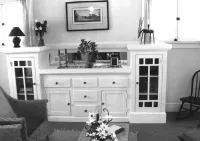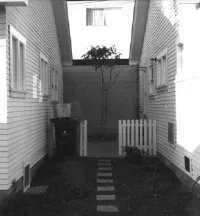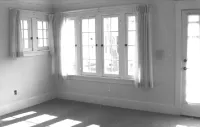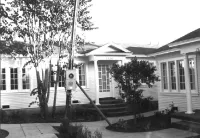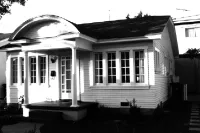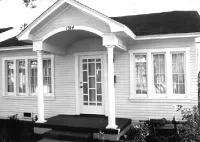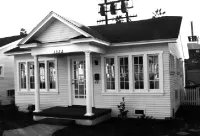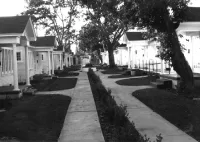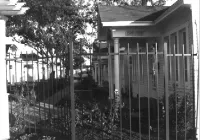Share what you know,
and discover more.
Share what you know,
and discover more.
May 31, 2008
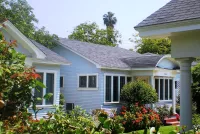
-

- Charmaine Bantugan
St. Andrews Bungalow Court
St. Andrews Bungalow Court is a grouping of bungalows built in 1919–20 in the Colonial Revival style in Hollywood, California. Based on the structures' well-preserved multi-family courtyard architecture, the grouping was added to the National Register of Historic Places in 1998. The listing included 15 contributing buildings. St. Andrews Bungalow Court was featured in the 2007 20th Century Fox movie Alvin and the Chipmunks as well as its 2009 sequel. It served as the home of Dave Seville (played by Jason Lee), one of the main characters of the movie. It was built as an investment for Fay Sudrow, a widow. It was "an example of an 'owner/builder' construction, a common practice in early Hollywood", in which standard, inexpensive, wood-frame construction was done, without use of an architect or non-essential decorative refinements. Architectural plans for part of the complex might have been purchased from a design service.
St. Andrews Bungalow Court
St. Andrews Bungalow Court is a grouping of bungalows built in 1919–20 in the Colonial Revival style in Hollywood, California. Based on the structures' well-preserved multi-family courtyard architecture, the grouping was added to the National Register of Historic Places in 1998. The listing included 15 contributing buildings. St. Andrews Bungalow Court was featured in the 2007 20th Century Fox movie Alvin and the Chipmunks as well as its 2009 sequel. It served as the home of Dave Seville (played by Jason Lee), one of the main characters of the movie. It was built as an investment for Fay Sudrow, a widow. It was "an example of an 'owner/builder' construction, a common practice in early Hollywood", in which standard, inexpensive, wood-frame construction was done, without use of an architect or non-essential decorative refinements. Architectural plans for part of the complex might have been purchased from a design service.
May 31, 2008
St. Andrews Bungalow Court
St. Andrews Bungalow Court is a grouping of bungalows built in 1919–20 in the Colonial Revival style in Hollywood, California. Based on the structures' well-preserved multi-family courtyard architecture, the grouping was added to the National Register of Historic Places in 1998. The listing included 15 contributing buildings.St. Andrews Bungalow Court was featured in the 2007 20th Century Fox movie Alvin and the Chipmunks as well as its 2009 sequel. It served as the home of Dave Seville (played by Jason Lee), one of the main characters of the movie.
It was built as an investment for Fay Sudrow, a widow. It was "an example of an 'owner/builder' construction, a common practice in early Hollywood", in which standard, inexpensive, wood-frame construction was done, without use of an architect or non-essential decorative refinements. Architectural plans for part of the complex might have been purchased from a design service.
Posted Date
Sep 19, 2022
Historical Record Date
May 31, 2008
Source Name
Wikipedia
Source Website
Delete Story
Are you sure you want to delete this story?
Mar 19, 1998
Mar 19, 1998
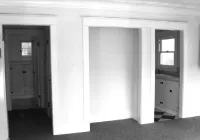
-

- Charmaine Bantugan
National Register of Historic Places
Statement of Significance: St. Andrews Bungalow Court is an excellent representation of an important and once common, but increasingly rare, building type in Los Angeles. As such, it is eligible for the National Register under Criterion C. It is an excellent example of a bungalow court, a type of multifamily housing which proliferated in Hollywood between 1910 and 1930. For many decades, these courts set the standard for modest housing in the area. However, the number of examples has dwindled due to intense development pressures. St. Andrews Bungalow Court remains an outstanding example of the type, unusual for its size and for the attention to individual detail bestowed upon each unit by its anonymous designers. A bungalow court is generally defined as several detached single family or duplex units facing a center court which is usually oriented perpendicular to the street. In almost all examples there is a slightly larger building at the rear facing into the center of the court. In some cases, this was the original house on the lot which was moved to the rear to build bungalows for rental income. In other cases, the rear building was built at the same time as the other buildings. In either case, it serves to anchor the principal axis of the court. The bungalow court was a very common form of housing all over the more densely settled areas of Los Angeles such as Hollywood, West Hollywood, “Echo Park, and Silverlake. In Hollywood there were innumerable bungalow courts, most of which generally resembled this court on North St. Andrews Place. The courts were commonly designed as builders' vernacular interpretations of American Colonial Revival or Spanish Colonial Revival style dwellings. Bungalow courts hold a specific place in the continuum of Hollywood development. Housing in Hollywood was mostly single-family residences in the community's early years. With Hollywood's incorporation into the City of Los Angeles in 1907 and the growth of the film industry in the late teens through early twenties, there was a large influx of new residents to Hollywood. These demographic shifts in the area created a demand for more and cheaper housing which caused the density of the area to increase. The prices and availability of land and the need for housing near major transportation routes also propelled the development of an increasingly dense form of housing. It was during this period that many bungalow courts were constructed, beginning around 1910 and continuing through the early 1930s. By the 1920s, however, land pressures in Hollywood necessitated the building of larger apartment buildings. Thus, the courts provided an alternative form of rental housing to the more urban apartment form. These buildings not only housed several times more people than the bungalow courts, but they also exhibited greater pretentions toward "style," as the fantasy which drove people to move to Hollywood manifested itself in domestic architecture. More formal, Beaux Arts and eclectic revival styles were the norm for these larger, more complex and sophisticated buildings. Also, unlike most bungalow courts, these apartment buildings were usually designed by architects. In some cases, a bungalow court would be constructed on two lots which were combined to create enough space for a court. By placing several essentially single-family homes on one lot or a double lot, the courtyard type economized on land and, at the same time, was only mildly disruptive to the development pattern of single-family neighborhoods. The units consciously attempted to duplicate the amenities of detached single-family houses, retaining the amenities of light, air, and open, verdant space between individual bungalows. As multifamily housing, they provided a common area which encourages interaction between residents, which must have been a welcome comfort to the many people who inhabited the courts as their first residence in Los Angeles. In the neighborhood in which St. Andrews Bungalow Court is located, there were many courts. A 1956 Sanborn Fire Insurance Map shows that were at least two-dozen true, two sided courts of the same type as St. Andrews located within four blocks in each direction of the St. Andrews court. Clearly demonstrating the population for whom the courts were constructed, a two-square-block facility of William Fox Studios was located one block away from St. Andrews Bungalow Court, and the other courts in the area are in similar proximity to film industry-related buildings, whether this facility or others such as the Louis B. Mayer Building at the southwest corner of Western Avenue and Hollywood Boulevard, which is located three blocks north and one block east of St. Andrews Bungalow Court. St. Andrew's Bungalow Court was built as an investment in 1919 and 1920 for Fay Sudrow, described as a widow in the deeds and mortgages. The court is an example of an "owner/builder" construction, a common practice in early Hollywood. Builder-built (as opposed to architect-designed) housing employs standard, inexpensive, wood-frame construction with minimal architectural and decorative refinements. The "agent" employed to construct the complex is identified as W. Jones, and the eight-room duplex in the back was built by a contractor identified as Frank Pece. No architect was identified, which suggests that Frank Pece may have purchased architectural plans from a design service. St. Andrews Bungalow Court is unique and exceptional in its size, style, and details. Yet at the same time it is paradigmatic and defines the best of what this type of housing had to offer. At sixteen units, St. Andrew's is the largest intact court in the area. The lot on which it is located is unusually large, measuring 100' by 250' in a neighborhood where the standard is 50' by 150'. This size of the lot allowed for a high number of bungalows with ample green space in between. The design of separate entrance treatments for each unit, described above, is rare and notable in this type of housing. It was uncommon for unique details such as these to be incorporated into a bungalow court, contributing to the significance and distinction of the property. All of the seven aspects of integrity remain present at St. Andrews Bungalow Court. The complex today is in excellent condition. While extensive deterioration and the presence of high levels of lead paint led to the selective removal of historic materials, the integrity of the complex remains high. On the exterior, all of the characteristic fenestration either remains intact or has been replicated. The siding which sheathes the building is original and has been restored. All exterior and interior doors and hardware remain or have been replaced, including the original, distinctive multipaned front doors. On the interior of each bungalow, cabinets and built-in features damaged during the building's abandonment have been restored or replaced. Features such as baseboards, door frame moldings, and coved ceilings are also intact. The continued presence of all of these character-defining features exhibits the court's integrity of design, materials, and workmanship, and feeling. While the neighborhood in which the property is located has changed in density since the court was built, each unit is oriented toward the center of the court, where the setting and feeling of the property remain intact. The existence of the mature trees referred to above is one of the primary features contributing to this continuity. The building also retains a high degree of integrity of association, as it continues to serve the purpose for which it was built, housing for moderate to low-income individuals. The cumulative loss of courtyard developments in the Hollywood Redevelopment Project Area and the Los Angeles area is a significant loss of style and type of development representative of an historic period. This net loss significantly increases the value of the St. Andrew's Bungalow Court as one of the few extant bungalow courts in the area. The property was rescued from deterioration and abandonment by Hollywood Community Housing Corporation, a non-profit developer of affordable housing. It is currently used as housing for a special need’s population. Some of the units have been slightly modified, two by the addition of entrance ramps, for handicapped accessibility. National Register Bulletin 15 states several requirements for a building to be eligible under Criterion C, one of which is that it must "embody distinctive characteristics of a type, period, or method of construction." St. Andrews Bungalow Court clearly meets this requirement. It is an unusually fine example of a bungalow court, an important property type in the development history of Hollywood. Its integrity and condition are very high, when properties of this type are dwindling significantly in number. It also stands as an excellent illustration of the ideal of the bungalow court and the type of housing environment the courts provided for people of modest means.
National Register of Historic Places
Statement of Significance: St. Andrews Bungalow Court is an excellent representation of an important and once common, but increasingly rare, building type in Los Angeles. As such, it is eligible for the National Register under Criterion C. It is an excellent example of a bungalow court, a type of multifamily housing which proliferated in Hollywood between 1910 and 1930. For many decades, these courts set the standard for modest housing in the area. However, the number of examples has dwindled due to intense development pressures. St. Andrews Bungalow Court remains an outstanding example of the type, unusual for its size and for the attention to individual detail bestowed upon each unit by its anonymous designers. A bungalow court is generally defined as several detached single family or duplex units facing a center court which is usually oriented perpendicular to the street. In almost all examples there is a slightly larger building at the rear facing into the center of the court. In some cases, this was the original house on the lot which was moved to the rear to build bungalows for rental income. In other cases, the rear building was built at the same time as the other buildings. In either case, it serves to anchor the principal axis of the court. The bungalow court was a very common form of housing all over the more densely settled areas of Los Angeles such as Hollywood, West Hollywood, “Echo Park, and Silverlake. In Hollywood there were innumerable bungalow courts, most of which generally resembled this court on North St. Andrews Place. The courts were commonly designed as builders' vernacular interpretations of American Colonial Revival or Spanish Colonial Revival style dwellings. Bungalow courts hold a specific place in the continuum of Hollywood development. Housing in Hollywood was mostly single-family residences in the community's early years. With Hollywood's incorporation into the City of Los Angeles in 1907 and the growth of the film industry in the late teens through early twenties, there was a large influx of new residents to Hollywood. These demographic shifts in the area created a demand for more and cheaper housing which caused the density of the area to increase. The prices and availability of land and the need for housing near major transportation routes also propelled the development of an increasingly dense form of housing. It was during this period that many bungalow courts were constructed, beginning around 1910 and continuing through the early 1930s. By the 1920s, however, land pressures in Hollywood necessitated the building of larger apartment buildings. Thus, the courts provided an alternative form of rental housing to the more urban apartment form. These buildings not only housed several times more people than the bungalow courts, but they also exhibited greater pretentions toward "style," as the fantasy which drove people to move to Hollywood manifested itself in domestic architecture. More formal, Beaux Arts and eclectic revival styles were the norm for these larger, more complex and sophisticated buildings. Also, unlike most bungalow courts, these apartment buildings were usually designed by architects. In some cases, a bungalow court would be constructed on two lots which were combined to create enough space for a court. By placing several essentially single-family homes on one lot or a double lot, the courtyard type economized on land and, at the same time, was only mildly disruptive to the development pattern of single-family neighborhoods. The units consciously attempted to duplicate the amenities of detached single-family houses, retaining the amenities of light, air, and open, verdant space between individual bungalows. As multifamily housing, they provided a common area which encourages interaction between residents, which must have been a welcome comfort to the many people who inhabited the courts as their first residence in Los Angeles. In the neighborhood in which St. Andrews Bungalow Court is located, there were many courts. A 1956 Sanborn Fire Insurance Map shows that were at least two-dozen true, two sided courts of the same type as St. Andrews located within four blocks in each direction of the St. Andrews court. Clearly demonstrating the population for whom the courts were constructed, a two-square-block facility of William Fox Studios was located one block away from St. Andrews Bungalow Court, and the other courts in the area are in similar proximity to film industry-related buildings, whether this facility or others such as the Louis B. Mayer Building at the southwest corner of Western Avenue and Hollywood Boulevard, which is located three blocks north and one block east of St. Andrews Bungalow Court. St. Andrew's Bungalow Court was built as an investment in 1919 and 1920 for Fay Sudrow, described as a widow in the deeds and mortgages. The court is an example of an "owner/builder" construction, a common practice in early Hollywood. Builder-built (as opposed to architect-designed) housing employs standard, inexpensive, wood-frame construction with minimal architectural and decorative refinements. The "agent" employed to construct the complex is identified as W. Jones, and the eight-room duplex in the back was built by a contractor identified as Frank Pece. No architect was identified, which suggests that Frank Pece may have purchased architectural plans from a design service. St. Andrews Bungalow Court is unique and exceptional in its size, style, and details. Yet at the same time it is paradigmatic and defines the best of what this type of housing had to offer. At sixteen units, St. Andrew's is the largest intact court in the area. The lot on which it is located is unusually large, measuring 100' by 250' in a neighborhood where the standard is 50' by 150'. This size of the lot allowed for a high number of bungalows with ample green space in between. The design of separate entrance treatments for each unit, described above, is rare and notable in this type of housing. It was uncommon for unique details such as these to be incorporated into a bungalow court, contributing to the significance and distinction of the property. All of the seven aspects of integrity remain present at St. Andrews Bungalow Court. The complex today is in excellent condition. While extensive deterioration and the presence of high levels of lead paint led to the selective removal of historic materials, the integrity of the complex remains high. On the exterior, all of the characteristic fenestration either remains intact or has been replicated. The siding which sheathes the building is original and has been restored. All exterior and interior doors and hardware remain or have been replaced, including the original, distinctive multipaned front doors. On the interior of each bungalow, cabinets and built-in features damaged during the building's abandonment have been restored or replaced. Features such as baseboards, door frame moldings, and coved ceilings are also intact. The continued presence of all of these character-defining features exhibits the court's integrity of design, materials, and workmanship, and feeling. While the neighborhood in which the property is located has changed in density since the court was built, each unit is oriented toward the center of the court, where the setting and feeling of the property remain intact. The existence of the mature trees referred to above is one of the primary features contributing to this continuity. The building also retains a high degree of integrity of association, as it continues to serve the purpose for which it was built, housing for moderate to low-income individuals. The cumulative loss of courtyard developments in the Hollywood Redevelopment Project Area and the Los Angeles area is a significant loss of style and type of development representative of an historic period. This net loss significantly increases the value of the St. Andrew's Bungalow Court as one of the few extant bungalow courts in the area. The property was rescued from deterioration and abandonment by Hollywood Community Housing Corporation, a non-profit developer of affordable housing. It is currently used as housing for a special need’s population. Some of the units have been slightly modified, two by the addition of entrance ramps, for handicapped accessibility. National Register Bulletin 15 states several requirements for a building to be eligible under Criterion C, one of which is that it must "embody distinctive characteristics of a type, period, or method of construction." St. Andrews Bungalow Court clearly meets this requirement. It is an unusually fine example of a bungalow court, an important property type in the development history of Hollywood. Its integrity and condition are very high, when properties of this type are dwindling significantly in number. It also stands as an excellent illustration of the ideal of the bungalow court and the type of housing environment the courts provided for people of modest means.
National Register of Historic Places
Statement of Significance:St. Andrews Bungalow Court is an excellent representation of an important and once common, but increasingly rare, building type in Los Angeles. As such, it is eligible for the National Register under Criterion C. It is an excellent example of a bungalow court, a type of multifamily housing which proliferated in Hollywood between 1910 and 1930. For many decades, these courts set the standard for modest housing in the area. However, the number of examples has dwindled due to intense development pressures. St. Andrews Bungalow Court remains an outstanding example of the type, unusual for its size and for the attention to individual detail bestowed upon each unit by its anonymous designers.
A bungalow court is generally defined as several detached single family or duplex units facing a center court which is usually oriented perpendicular to the street. In almost all examples there is a slightly larger building at the rear facing into the center of the court. In some cases, this was the original house on the lot which was moved to the rear to build bungalows for rental income. In other cases, the rear building was built at the same time as the other buildings. In either case, it serves to anchor the principal axis of the court. The bungalow court was a very common form of housing all over the more densely settled areas of Los Angeles such as Hollywood, West Hollywood, “Echo Park, and Silverlake. In Hollywood there were innumerable bungalow courts, most of which generally resembled this court on North St. Andrews Place. The courts were commonly designed as builders' vernacular interpretations of American Colonial Revival or Spanish Colonial Revival style dwellings.
Bungalow courts hold a specific place in the continuum of Hollywood development. Housing in Hollywood was mostly single-family residences in the community's early years. With Hollywood's incorporation into the City of Los Angeles in 1907 and the growth of the film industry in the late teens through early twenties, there was a large influx of new residents to Hollywood. These demographic shifts in the area created a demand for more and cheaper housing which caused the density of the area to increase. The prices and availability of land and the need for housing near major transportation routes also propelled the development of an increasingly dense form of housing. It was during this period that many bungalow courts were constructed, beginning around 1910 and continuing through the early 1930s. By the 1920s, however, land pressures in Hollywood necessitated the building of larger apartment buildings. Thus, the courts provided an alternative form of rental housing to the more urban apartment form.
These buildings not only housed several times more people than the bungalow courts, but they also exhibited greater pretentions toward "style," as the fantasy which drove people to move to Hollywood manifested itself in domestic architecture. More formal, Beaux Arts and eclectic revival styles were the norm for these larger, more complex and sophisticated buildings. Also, unlike most bungalow courts, these apartment buildings were usually designed by architects.
In some cases, a bungalow court would be constructed on two lots which were combined to create enough space for a court. By placing several essentially single-family homes on one lot or a double lot, the courtyard type economized on land and, at the same time, was only mildly disruptive to the development pattern of single-family neighborhoods. The units consciously attempted to duplicate the amenities of detached single-family houses, retaining the amenities of light, air, and open, verdant space between individual bungalows. As multifamily housing, they provided a common area which encourages interaction between residents, which must have been a welcome comfort to the many people who inhabited the courts as their first residence in Los Angeles.
In the neighborhood in which St. Andrews Bungalow Court is located, there were many courts. A 1956 Sanborn Fire Insurance Map shows that were at least two-dozen true, two sided courts of the same type as St. Andrews located within four blocks in each direction of the St. Andrews court. Clearly demonstrating the population for whom the courts were constructed, a two-square-block facility of William Fox Studios was located one block away from St. Andrews Bungalow Court, and the other courts in the area are in similar proximity to film industry-related buildings, whether this facility or others such as the Louis B. Mayer Building at the southwest corner of Western Avenue and Hollywood Boulevard, which is located three blocks north and one block east of St. Andrews Bungalow Court.
St. Andrew's Bungalow Court was built as an investment in 1919 and 1920 for Fay Sudrow, described as a widow in the deeds and mortgages. The court is an example of an "owner/builder" construction, a common practice in early Hollywood. Builder-built (as opposed to architect-designed) housing employs standard, inexpensive, wood-frame construction with minimal architectural and decorative refinements. The "agent" employed to construct the complex is identified as W. Jones, and the eight-room duplex in the back was built by a contractor identified as Frank Pece. No architect was identified, which suggests that Frank Pece may have purchased architectural plans from a design service.
St. Andrews Bungalow Court is unique and exceptional in its size, style, and details. Yet at the same time it is paradigmatic and defines the best of what this type of housing had to offer. At sixteen units, St. Andrew's is the largest intact court in the area. The lot on which it is located is unusually large, measuring 100' by 250' in a neighborhood where the standard is 50' by 150'. This size of the lot allowed for a high number of bungalows with ample green space in between. The design of separate entrance treatments for each unit, described above, is rare and notable in this type of housing. It was uncommon for unique details such as these to be incorporated into a bungalow court, contributing to the significance and distinction of the property.
All of the seven aspects of integrity remain present at St. Andrews Bungalow Court. The complex today is in excellent condition. While extensive deterioration and the presence of high levels of lead paint led to the selective removal of historic materials, the integrity of the complex remains high. On the exterior, all of the characteristic fenestration either remains intact or has been replicated. The siding which sheathes the building is original and has been restored. All exterior and interior doors and hardware remain or have been replaced, including the original, distinctive multipaned front doors. On the interior of each bungalow, cabinets and built-in features damaged during the building's abandonment have been restored or replaced. Features such as baseboards, door frame moldings, and coved ceilings are also intact. The continued presence of all of these character-defining features exhibits the court's integrity of design, materials, and workmanship, and feeling. While the neighborhood in which the property is located has changed in density since the court was built, each unit is oriented toward the center of the court, where the setting and feeling of the property remain intact. The existence of the mature trees referred to above is one of the primary features contributing to this continuity. The building also retains a high degree of integrity of association, as it continues to serve the purpose for which it was built, housing for moderate to low-income individuals.
The cumulative loss of courtyard developments in the Hollywood Redevelopment Project Area and the Los Angeles area is a significant loss of style and type of development representative of an historic period. This net loss significantly increases the value of the St. Andrew's Bungalow Court as one of the few extant bungalow courts in the area. The property was rescued from deterioration and abandonment by Hollywood Community Housing Corporation, a non-profit developer of affordable housing. It is currently used as housing for a special need’s population. Some of the units have been slightly modified, two by the addition of entrance ramps, for handicapped accessibility.
National Register Bulletin 15 states several requirements for a building to be eligible under Criterion C, one of which is that it must "embody distinctive characteristics of a type, period, or method of construction." St. Andrews Bungalow Court clearly meets this requirement. It is an unusually fine example of a bungalow court, an important property type in the development history of Hollywood. Its integrity and condition are very high, when properties of this type are dwindling significantly in number. It also stands as an excellent illustration of the ideal of the bungalow court and the type of housing environment the courts provided for people of modest means.
Posted Date
Sep 19, 2022
Historical Record Date
Mar 19, 1998
Source Name
National Register of Historic Places
Source Website
Delete Story
Are you sure you want to delete this story?


